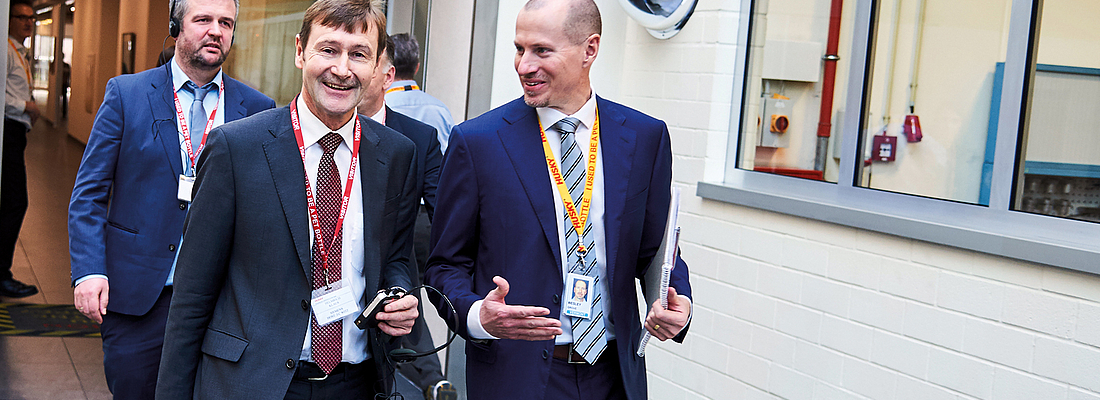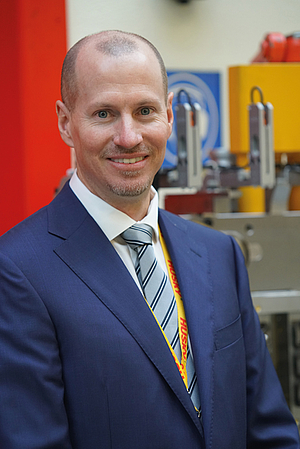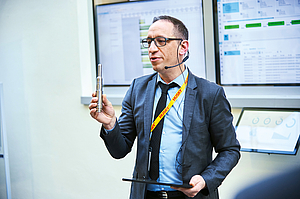

Interview by Dr. Otto Appel with Wesley Grove, Vice President Operations - Next Generation Operation Model.

CC: Mr. Grove, your career began with Husky in 2000 as a designer in the Hot Runners and Controllers business in Vermont and you have been Vice President of Husky’s Next Generation Operating Model (NGOM) since September 2017. Husky is very active in restructuring the organization. How did you approach it and how has it been received by the company?
Grove: The first step was aligning around a common vision from our President and CEO, John Galt. Husky’s goal is to become a top industrial company, a path that we’ve been on for some time. How do we leverage Husky’s unique attributes to achieve this goal in the face of a changing consumer environment and a global trend around Industry 4.0. At Husky, we have global scale in operating footprint, one of the richest data pools in the industry from years of leadership and development across the market, and a history of industrialization of the mold making process.
CC: Yes, but the question is: How do you build an operating model around those attributes such that you gain a competitive advantage in the way you delivers your products and services to your customers?
Grove: When you look at what is going on in the rest of the world and in your personal life: Almost everything is available in real time. You can order everything online and have it delivered the next day, sometimes the same day. We see similar trends in our industry: Our customers want to make decisions later to have more certainty and they want to get to the solution and the products faster with the absolute best quality. Our strategy was born around meeting these demands of flexibility, mass customization, speed, and quality. Together with Siemens and other partners, our teams developed a proof of concept to show what a digital endto-end process would look like for one of our products. The goal was to learn as much as possible about the impact this could have on quality, speed, and cost. And that’s when we introduced the idea of reducing the timeline from 45 days down to one day for that product. The next step was scaling this idea from proof of concept to production ready and this is where a strong change management program is required to align people, processes and tools to leverage this new capability. This requires putting the right people in the right seats, enabling them to be successful through training and mentorship, and setting challenging and focused goals to deliver on the solution. Our partnership with the Luxembourg government through the Skills Bridge program has helped us to accelerate the retraining and upskilling of our workforce to support this goal.
CC: So, you always worked on quality, you always worked on cost. But speed, in that sense, is a new one.
Grove: Yes, speed in that form is a new focus. Traditionally, customers’ projects go back and forth through different company “silos” throughout the project lifecycle and these hand-offs and communication points take time and can introduce opportunity for error. Thinking from a customer perspective they are interested in access to the right information quickly to make decisions. Once that decision is made, they’d like to have their product or service as quickly as possible.
Wesley Grove, Vice President Operations, Husky “The goal is to deliver the highest quality engineering through the most efficient model. For us, it is a journey that has just begun.”
This will only accelerate as new generation(s) of workers enter our industry, a generation accustomed to buying and interfacing with companies in a more seamless manner, with speed, and through a delightful customer experience. The driver of speed forces you to rethink not only how you build a business model around leveraging knowledge and data, but also how you design your processes, tools and organization to enable that capability.
CC: If you think back to the old days: You had to design the preform which took time. You had to design the mold and test the mold – which also took time. Time saving potential in these areas seems limited. How did you approach the challenge of deriving the time saving potential through digital solutions?
Grove: You must optimize the entire process. We asked ourselves: “Imagine we had no constraints: How fast could we go end-to-end?” From the time the customer says, “I have an idea” to the time they have the part in their hands. How long could that time be if we did not constrain ourselves with the tools, the processes, the footprint, or the organization that we have today. And then we laid out that process. And we started to see a lot of opportunity to reduce time. For example, you are still engineering. The difference is that you are not engineering every job manually and engineering is not focused on only their “silo” but rather their impact on the overall process. Let me put it this way: If you put the knowledge of an engineer in a system based on rules, the function they are performing is only limited by computing power as it relates to speed. This is an over-simplification but conveys the point.

CC: But you cannot integrate everything into one system and the work is done?
Grove: There are still things that cannot be completed digitally, nor do we intend to fully digitize. For example, applications with less maturity in industrialization, including custom and low volume solutions. But thinking about Husky’s scale again, the number of molds, PET molds, we have produced over the last 30 years gives us a massive amount of information that we can turn into knowledge that can be used in our NGOM to enable speed applying that knowledge to deliver the end-to-end or service.
CC: Does this mean that the process is more predictable at an earlier stage? Can you make decisions faster concerning all this newly available data?
Grove: NGOM has a foundation in data and Industry 4.0 technologies, including the concept of Digital Twin. Using real-time, quality data in conjunction with a virtual twin, a virtual (digital) replication of the physical process, allows us to predict performance at the early stages of a project. As I stated earlier, Husky has a wealth of data from our scale as a leading provider to the industry. Leveraging this data to make faster, better decisions is one of the enablers of our new operating model. An example in practice would be our solutioning teams. Providing transparent access to all solutioning data, new and old, across all regions, with a consistent level of quality allows the team to create the best solutioning model for each application and in turn provide solutions with speed and higher quality. Traditionally, this has been a more siloed approach.
CC: But that also means: The solutions have already been available in the past. There is no new knowledge as such, only new knowledge of how to obtain and use data..
Grove: It’s true that we’ll leverage our stock of existing data and knowledge in a more effective manner, but also that we’ll constantly be increasing our knowledge through learning about new applications or learning about how effective we produce our products. Industry 4.0 is all about connectivity between the virtual and physical worlds, between the people and the systems with which they interface. You make a prediction of performance, measure the actual versus the prediction, and evolve your knowledge and understanding of how to solution, produce, etc.
CC: If you look at the whole process from preform to bottle: Where does the time reduction come from?
Grove: It really comes from the entire process. In almost every company you have functional channels. For example, our engineering department. The goal is to deliver the highest quality engineering through the most efficient model. That is good, but how do you interface with the solutioning department and with the manufacturing department so that information flows seamlessly? Do they have to translate data in a form they can work with? Through specialization, we are very good in our channels. But looking at the whole process in an end-to-end fashion is the mindset shift that Husky and Siemens have gone through and the foundation of our NGOM.
CC: So, you look at the whole process, you optimize that process and then you look at the available tools to get this process running in the same way. Grove: Yes, you must start with the end in mind and for Husky that meant delivering the highest quality, fast, and with flexibility. What is the process that will deliver these capabilities at the desired customer experience, and then through working with partners like Siemens, which technologies will facilitate that process? In parallel you design an organizational model to leverage this new capability.
CC: So that leads us back to our first question. How is this change received in the organization, as the work and job descriptions change dramatically?
Grove: In any transformation the workforce is the most challenging aspect because there are many dynamics that you don’t have when developing a new technology. What excites me about our team at Husky is we have great innovators and problem solvers at all levels of the organization. You need an inquisitive and open mind to think about how to accomplish a goal that likely has many contradictions. It’s important to have transparent and frequent communication so that people know how they fit in to the organization and can contribute. A transformation like this brings a lot of opportunity for career enhancement and job enrichment and the role of the transformation leaders is to make sure that the workforce is enabled to be successful and to take advantage of these opportunities. Programs like Skills Bridge in partnership with the Luxembourg government provide great support for retraining the workforce for the jobs of the new operating model and we are looking to leverage this program and others to ensure we both retain and attract the best talent. Overall, the team is excited to have the opportunity to define and execute on the NGOM. The people are the hardest piece.
Wesley Grove “A transformation like this brings a lot of opportunity for career enhancement and job enrichment.”
We have had a lot of discussions about this. The technology is complicated, but it is solvable. Getting our workforce excited and confident in our new strategy is another challenge. That is why we started with a pilot. With people who had an open mind and a broad set of capabilities. And then, like a start-up, we said: Just go, make it work and see what’s possible. Now that we scale up, we are obviously bringing a lot of our workforce into that new environment. And it is scary for people because there are concerns that you are going to automate everything and there will no longer be a need for human skill. These concerns are more frequent than you might think. But also, some people look at it as an opportunity. They are saying “Finally…I love this!”
CC: And for this Luxembourg is a perfectly suited environment?
Grove: Luxembourg is our EMEA headquarters and here we have a great team and capability to serve our industry and our customers. In our digitalization journey Luxembourg has offered an environment where not only can our digital and operations teams work closely together to develop the NGOM solution, but we also have support of the government and are in close proximity to many of our partners. It’s evident that Luxembourg sees a high value in leading in Industry 4.0 as demonstrated by where they are investing their money and time. All these factors enabled us to move quickly in developing NGOM.
CC: When you started with this, did you have a specific target? For example, reducing the delivery time for molds by 50 or 70 percent?
Grove: We started with a seemingly impossible goal to force us to break out of our current mindset. Once the team accepted the goal and a “greenfield” way of thinking the processes and solution came together. We did not have specific time reductions in mind. We are still in the phase of evaluating “what is the market need?”
CC: NGOM will also generate a huge advantage in the spare part business, regarding speed and manufacturing on demand.
Grove: Indeed. Right now, we are in a stage of demonstrating a prototype, scaling to production and offering products produced with this model to our customers at breakthrough speed and quality levels. Is that valuable? We believe it is and are aggressively looking to scale up through our Rigid Packaging business. Our Spare Parts business would certainly benefit from this capability and we are evaluating how and when NGOM with launch in other areas of our company.
CC: But we still work with the same questions: it’s about quality, it’s about cost, it’s about speed. I remember 30 years ago, when we strategically looked at the process, the story was exactly the same. Look at the whole process and optimize every bit of it. With the vast digital opportunities, do you have to completely rethink your manufacturing business?
Grove: The foundation of NGOM is real-time, quality data and new digital technologies that provide connectivity throughout the digital ecosystem, including interactions with our customers and our workforce. It does require a rethinking of all areas of the business. While the same questions have been asked for years, the solutions we see today are new and constantly evolving. We’ve rethought how we deliver products and services from end-to-end, in a sustainable and highly connected business model. I’m excited for the opportunity to leverage these new capabilities and to work with such inspiring teams to bring this new capability to our customers.
The comPETence center provides your organisation with a dynamic, cost effective way to promote your products and services.

magazine
Find our premium articles, interviews, reports and more
in 3 issues in 2026.



